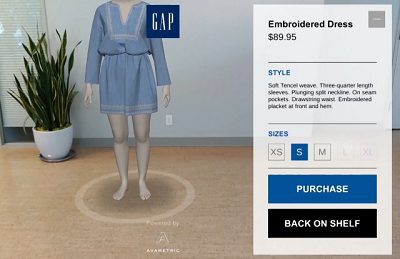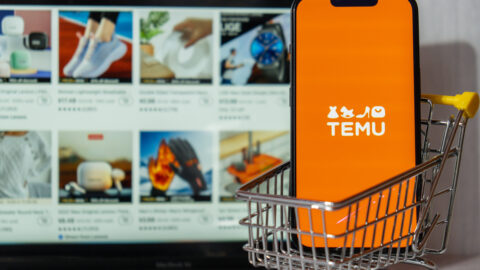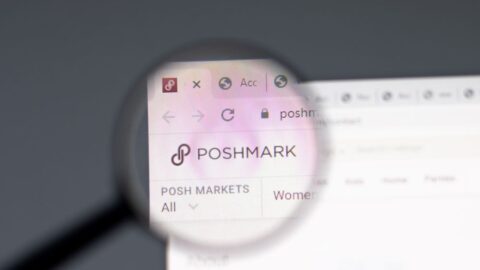Return rates as high as 30% to 40% have been a long-standing challenge for online apparel retailers. Gap‘s new DressingRoom app, which uses augmented reality (AR) to help shoppers see how its clothes will fit before they place an order, takes aim at the problem.
Shoppers enter their height and weight into the app and select one of five body types, which displays a virtual 3D model to show how different items will fit. If shoppers see something they like, they can buy it from within the app.
“Gap has been working on the fit of our products to better match the way customers are shaped instead of just looking at ‘fit model’ sizes,” said Gil Krakowsky, VP Global Strategy and Business Development at Gap in a blog post. “One of our top priorities is continuing to improve our technical knowledge around how fabric stretch, drape and feel impact the sensation of fit.”
Currently the app, developed by Google and Avametric, is available only on Google Tango smartphones, but technological incompatibility may be the least of Gap’s concerns. Last year’s Pokémon Go phenomenon demonstrated AR’s potential, but it’s still a long way from simulating the sensations of actually trying on a piece of clothing in person. Still, Gap could use the app to collect valuable data, testing the waters for future technologies that are more capable of bridging the offline-online gap in apparel retailing.
Brain Trust Weighs In On AR-Powered App
A recent RetailWire article explored whether the DressingRoom app has the potential to replace (or complement) an actual dressing room and solicited a range of opinions from the RetailWire brain trust. Some of their comments are excerpted below.
Chris Petersen, PhD, President, Integrated Marketing Solutions
There is a big difference between the Pokémon Go experience and a woman trying on a dress. At this stage, the AR experience will not be sufficient to convert very many online sales. However, it may be much like Lowe’s at home “visualization of your room” experience…it may play a role in pre-store engagement and narrowing selection before the store visit. In an omnichannel world it is not about where the sales transaction takes place…it is about the cumulative experiences that build engagement and trust to the levels where the consumer decides where, how and when to make a purchase.
Max Goldberg, President, Max Goldberg & Associates
The AR-enabled dressing room is a nice gimmick, but it’s premised on having clothes that a customer wants. And there Gap has a problem.
Shep Hyken, Chief Amazement Officer, Shepard Presentations
This is just the beginning. Right now it’s cool — and some may consider it a gimmick. As it is refined, it will be a great way to help customers make choices. But for that to happen, the image of the mannequin (with a choice of five body types) has to be replaced with an image of the customer. Uploading a customer’s picture which the computer can use to fit images of merchandise to the customer’s body can’t be that far away. And when that happens the virtual dressing room will take off.
Marge Laney, CEO, Alert Tech
Anything that can help the dismal conversion and return problem for online retailers is a plus. But no buying decision is final until the try-on has been completed, whether that’s in the fitting room or at home. AR can increase the fidelity of the online experience but will never replace the actual try-on when the items are received. The correct fit, feel and look can only be determined when the item is tried on.
Ricardo Belmar, Senior Director, Worldwide Enterprise Product Marketing, InfoVista
With an app based on multiple “body types” we’re not talking about near-100% fit accuracy that can be achieved with 360 degree scanners. Having been through such a scanning process at Alton Lane and purchasing the resulting clothing, I can say the scanning approach does produce fantastic accuracy in fit and has made me a loyal customer. We’ll see if this app garners enough adoption to move the needle — but it does assume Gap already has the product assortment customers want. It doesn’t address that issue.
Cynthia Colcomb, Founder/CEO Prefeye – Preference Science Technologies
A visual representation in a fitting room or scanning my body for measurements has nothing to do with my sensory preferences of fit, look, and feel. If sensory preferences are not met, the result is a return or a closet with the tags dangling.
Lee Peterson, EVP Brand, Strategy & Design, WD Partners
Okay, this is how I can tell I’m still a digital immigrant: I just don’t get VR for retail. Using it to try something on? Really? I’d MUCH rather just order it online and send it back if it doesn’t fit. I’m an expert now at sending things back, mostly because retailers (out of necessity) have made it so easy. Do we think that maybe if the stores were more inviting and interesting and the sales associates were awesome that we’d want to go to the store (more often) to try things on? I’m just saying: blocking and tackling vs. whiz bang — works every time.













